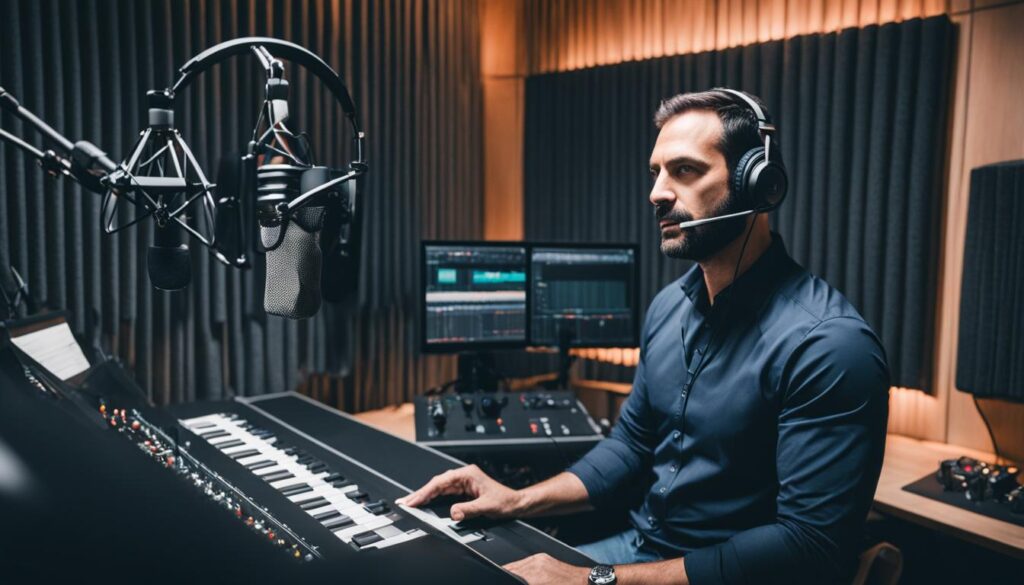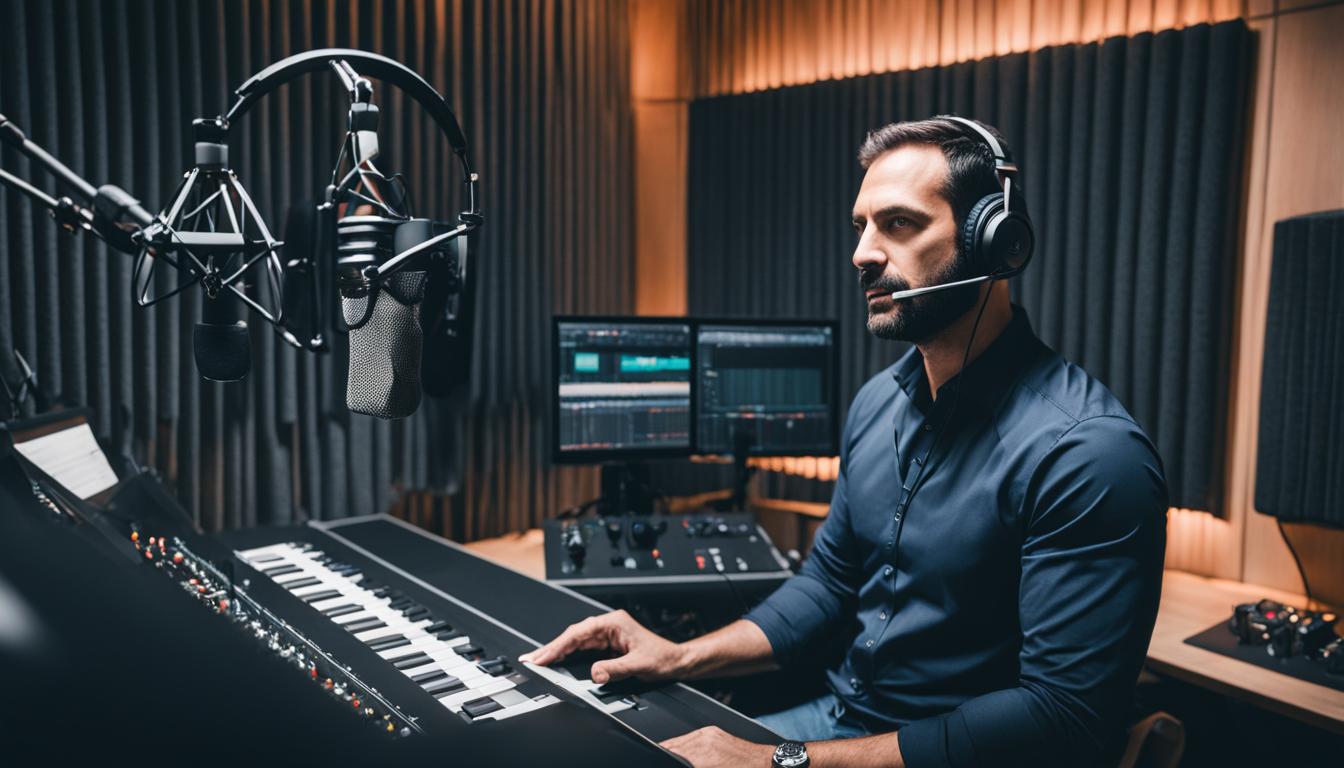Welcome to this guide on achieving high-quality audio as an audiobook narrator. As a professional narrator, I understand the importance of providing listeners with crystal-clear sound that enhances the story and captivates their imagination. In this article, I will share essential tips and techniques to take your audio recordings to the next level.
In today’s competitive audiobook market, high-quality sound can make all the difference. By following these tips, you’ll be able to deliver audio recordings with exceptional clarity and professionalism.

Key Takeaways:
- Creating the right recording environment is crucial for optimal audio quality.
- Choosing the right microphone and understanding proper placement techniques are essential for achieving clear and professional audio.
- A professional audio interface can improve sound quality by bridging the gap between the microphone and computer.
- Post-processing and editing are vital for removing imperfections and enhancing overall sound quality.
- Regular monitoring and quality control are necessary to ensure consistent and high-quality audio recordings.
Creating a Suitable Recording Environment
As an audiobook narrator, one of the key factors that can affect your recording quality is the environment in which you record. To ensure optimal audio quality, it’s crucial to select a quiet and controlled space free from external noise, such as traffic or background disturbances.
When choosing a recording environment, consider using acoustic treatments or soundproofing materials to minimize echo and reverberation and ensure a clean and natural sound. You can use blankets, acoustic foam panes, or soundproof curtains to keep the acoustics in check.
Finally, it’s important to ensure that your recording space is comfortable and suits your needs. Whether you prefer a standing or sitting position while narrating, keep in mind that a happy narrator produces better work.
Tip: If you are recording in a non-ideal acoustic space, inserting noise-reducing materiels around you can help reduce ambient and background noise so that your audiobook quality isn’t compromised.
Selecting the Right Microphone
If you want to achieve high-quality audio as an audiobook narrator, selecting the right microphone is crucial. While there are many options available, consider using a condenser microphone, as it offers superior sensitivity and captures more detail.
Additionally, it’s important to choose a microphone that complements your voice and style of narration to bring out the best in your audio recordings. Keep in mind that a high-quality microphone doesn’t have to break the bank. There are many great options for under $200 that provide excellent sound quality.
Before making your final selection, do your research. Read reviews from other audiobook narrators and listen to audio samples recorded with different microphones. This will give you a better idea of which microphones are well-suited for audiobook narration.
Understanding microphone placement
As an audiobook narrator, understanding proper microphone placement is crucial to capturing crystal-clear audio. Experimenting with different distances and angles can help you find the sweet spot where your voice sounds the best. It’s essential to avoid placing the microphone too close to your mouth, as this may lead to excessive plosives or breath sounds. A good rule of thumb is to place the microphone about six inches away from your mouth.
The best microphone placement will depend on your recording environment and the type of microphone you’re using. In a noisy environment, consider using a directional microphone, which is better at rejecting ambient noise from the sides and rear. Alternatively, if you’re recording in a sound-treated environment, a condenser microphone may be a good choice, as it captures more detail and nuance in your voice.
When positioning your microphone, be aware of any reflections or echoes that may affect the sound quality. If you’re in a room with hard surfaces, such as walls, ceilings, or floors, try to place the microphone as far away from these surfaces as possible. You may also want to use acoustic treatments, such as foam panels or portable vocal booths, to further reduce unwanted reflections.
Remember, achieving high-quality audio for your audiobook narration requires attention to detail and careful consideration of all factors involved. Proper microphone placement is just one piece of the puzzle. By combining good microphone technique, suitable recording environments, and professional-grade equipment such as a high-quality audio interface, you can captivate listeners and deliver an immersive listening experience.
Setting up a Professional Audio Interface
As an audiobook narrator, the quality of your audio recordings hinges on the equipment you use. And a professional audio interface is one such equipment that can bridge the gap between your microphone and computer, enhancing audio quality in the process.
When selecting an audio interface, prioritize the quality of preamps and converters. Preamps are responsible for amplifying the signal from your microphone, while converters digitize the signal for computer processing. Therefore, it’s crucial to invest in an interface with high-end preamps and converters to ensure accurate and pristine sound reproduction.
After you acquire a professional audio interface, take the time to understand its settings and functions. This way, you can adjust them accordingly to optimize your setup for optimal results. Don’t hesitate to consult the manufacturer’s manual, online tutorials, or even an audio engineer to get more insight into your interface.
By setting up a professional audio interface, you’ll improve the quality of your audio recordings significantly. The outcome will be delightful to your listeners’ ears and make your narration more captivating.
Applying Proper Microphone Technique
As an audiobook narrator, your microphone technique plays a vital role in delivering high-quality audio. To ensure crystal-clear sound, it is essential to maintain a consistent distance from the microphone throughout your recording. Avoid any sudden movements or changes in volume, as they can result in distracting noises or uneven audio levels.
Pro Tip: Prioritize good breath control techniques. Proper breathing not only helps you maintain consistent volume levels but also helps prevent unwanted background noises, such as mouth clicks or pops.
Remember, consistent microphone technique is key to producing clear and professional-sounding audio. Take the time to experiment and find the technique that works best for you.
Post-processing and Editing
Now that you have recorded your audiobook with proper technique and high-quality equipment, it’s time for post-processing and editing. This is a crucial step in achieving the best audio quality possible for your listeners.
Start by importing your audio files into an audio editing software. Use tools such as noise reduction to remove any unwanted background noise, clicks, or pops that might have occurred during recording. Apply compression to balance out your audio levels and improve the overall sound quality. Additionally, use equalization to boost certain frequencies or remove any unwanted ones, making the audio sound more pleasing to the listener’s ears.
Remember to keep it subtle and natural. Overprocessing can lead to an unnatural and unpleasant listening experience.
Tip: Take frequent breaks during editing to avoid ear fatigue and ensure that you are making accurate editing decisions.
After editing, give your ears a break and come back with fresh ears to listen for any last-minute tweaks or improvements. Once satisfied with your final product, export your audio files and move on to the next step of your audiobook production process.
Audiobook Narrator Audio Quality Tips: Monitoring and Quality Control
As a professional audiobook narrator, monitoring and quality control play a critical role in ensuring high-quality audio recordings. Keeping a close eye on your audio levels and taking the necessary steps to address any issues promptly can make all the difference in delivering a consistent listener experience.
I always use high-quality headphones or studio monitors to closely monitor my audio recordings during the recording and editing process. This helps me catch any anomalies or imperfections that may compromise audio quality.
I advise regularly checking your audio levels and monitoring for any distortions, background noise, or unwanted sounds during recording and editing. This simple yet effective practice can help you produce better quality audio and elevate your audiobook narration skills.
Remember, quality control doesn’t end after recording. You should also review your final product to ensure it meets the required standard before publishing.
Monitoring and quality control are essential components of achieving high-quality audio as an audiobook narrator. Don’t let anything compromise sound quality and take the necessary steps to address issues promptly. By doing so, you can deliver a flawless listening experience that audiences are sure to love!
